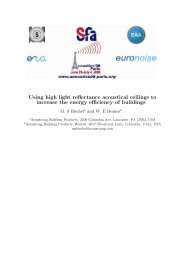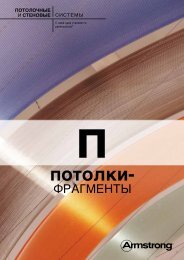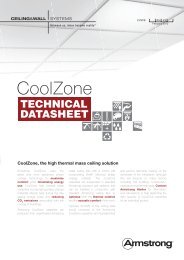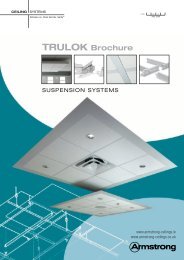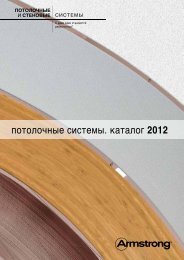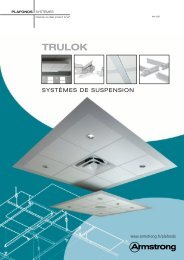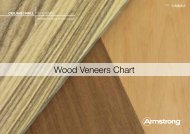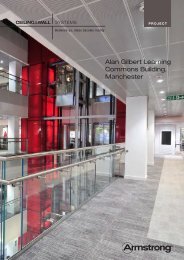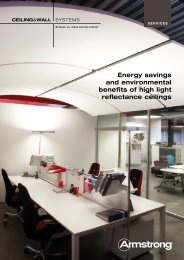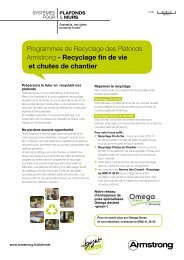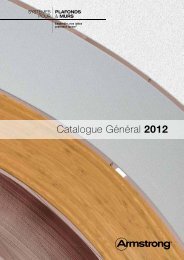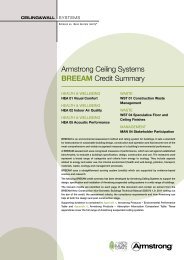Metal ceilings & Walls - ARMSTRONG - Atelier
Metal ceilings & Walls - ARMSTRONG - Atelier
Metal ceilings & Walls - ARMSTRONG - Atelier
Create successful ePaper yourself
Turn your PDF publications into a flip-book with our unique Google optimized e-Paper software.
techNicAL iNForMAtioN<br />
metal <strong>ceilings</strong> & walls :::: 53<br />
<strong>Metal</strong> walls and <strong>ceilings</strong> can be used in schools, offices, transport facilities, industrial buildings and also hospitals where<br />
their cleanability makes them ideal to meet the clean room standards required in the healthcare sector.<br />
eN 13501-1<br />
Fire reaction<br />
National Building regulations (where applicable) require that<br />
buildings meet the appropriate euroclass fire reaction performance<br />
depending upon the area of application. Armstrong products have<br />
been tested to the harmonised european fire reaction standards<br />
and meet the minimum performance criteria. Many Armstrong<br />
products have also been tested for their fire resistance performance<br />
under various floor constructions.<br />
<strong>Metal</strong> tiles do not burn and contain no volatile organic components.<br />
<strong>Metal</strong> provides protection against fire and can also provide a shield<br />
against radio waves due to their conductivity. As well, many of<br />
our acoustical metal <strong>ceilings</strong> and walls achieve a fire class of A1<br />
according to eN 13501-1.<br />
Thermal Conductivity<br />
the ever increasing commitment to energy conservation, dictates<br />
that buildings should be as energy efficient as is compatible<br />
with their function, use and as specified in national building<br />
regulations. interior building products which can form part of the<br />
external structure, such as suspended <strong>ceilings</strong> beneath a roof<br />
construction, can contribute to minimising the loss of heat to the<br />
exterior by reference to their thermal conductivity values. Armstrong<br />
conducts extensive tests of thermal conductivity on a wide range<br />
of its products, in accordance with eN 12667 (as specified in eN<br />
13964) and iSo 8301, by third party accredited laboratories. the<br />
thermal conductivity values indicated on each product data page<br />
are as determined by these tests.<br />
Armstrong <strong>Metal</strong> <strong>ceilings</strong> products have been tested<br />
to meet a variety of fire test classifications<br />
Plain without acoustic infill<br />
eeA euroclass A1 (rAL 9010)<br />
eeA euroclass A2-s1, d0 (other colours)<br />
eeA euroclass B-s1, d0 (with gasket)<br />
Perforated without acoustic infill<br />
eeA euroclass A1 (rAL 9010)<br />
eeA euroclass A2-s1, d0 (other colours)<br />
eeA euroclass B-s1, d0 (with gasket)<br />
With fleece, aluminium foil black tissue faced (AFBTF)<br />
pad or B15 or OP19 infill<br />
Perforated ø ≤ 2.5 mm (acoustic fleece)<br />
eeA euroclass A2-s2, d0<br />
(euroclass A1 performance available on special request).<br />
Perforated ø ≤ 2.5 mm (acoustic fleece and gasket)<br />
eeA euroclass B-s2, d0<br />
Perforated ø ≤ 2.5 mm (AFBtF pad)<br />
eeA euroclass A1<br />
Perforated ø ≤ 2.5 mm (Premium B15 infill)<br />
eeA euroclass A2-s1, d0<br />
Perforated ø ≤ 2.5 mm (metal oP19 infill)<br />
eeA euroclass A2<br />
Pattern<br />
Thermal conductivity<br />
W/mK<br />
Plain (unperforated), no inlay 0,244<br />
Plain (unperforated), with fleece 0,163<br />
Plain (unperforated), with 8mm (100 kg/m 3 )<br />
aluminium foil wrapped mineral wool 0,187<br />
Plain (unperforated), with fleece and B15 0,0731<br />
Cleaning and disinfection<br />
the frequency and cleaning method of a ceiling varies from<br />
one application to another. All products can at least be cleaned<br />
with a dry cloth or vacuum cleaner.<br />
Wipeable with a dry cloth.<br />
Wipeable with a moist cloth.<br />
Washable with a sponge dampened in water<br />
containing mild soap or diluted detergent.<br />
Scrubbable with water containing mild soap or<br />
diluted detergent (for plain tiles or perforated tiles<br />
without a fleece).<br />
can be cleaned using a high pressure water spray<br />
(high pressure water cleaning solution is using metal<br />
clip-in Plain).<br />
can be cleaned with disinfectants commonly used in<br />
healthcare premises (metal Bioguard solutions).<br />
Air leakage<br />
the cavity above a suspended ceiling may be used as part of<br />
the mechanical air distribution system, when it is used as<br />
a supply or extract plenum, and the air pressure in the<br />
plenum will be either positive or negative in comparison<br />
to the pressure in the room below. Similarly for ‘clean<br />
room’ applications, where it is most important to prevent<br />
the ingress of airborne dust contaminants, the room will be<br />
at positive pressure to the surrounding areas. Alternatively, to<br />
escape the egress of pathogens the room may be kept at a lower<br />
pressure relative to the surrounding areas. in these situations, it<br />
is necessary to know how much air leakage occurs through the<br />
ceiling system as a result of the pressure differential. Armstrong<br />
conducts extensive tests of air leakage on a wide range of<br />
its products, in accordance with eN 12114 and eN 13829,<br />
by third party accredited laboratories. Please contact Armstrong<br />
technical Sales for further details of these results.<br />
Air flow<br />
When using perforated metal suspended <strong>ceilings</strong>, the cavity<br />
above may be used as part of the mechanical air distribution<br />
system when it is used as a supply plenum. With this<br />
arrangement the air pressure in the plenum is always positive<br />
in comparison to the pressure in the room below. Specific tiles<br />
can be selected as open (active), and these will become air<br />
diffusers, while the remaining tiles will have their perforations<br />
blocked (inactive). in this way the air flow supply volume to the<br />
room can be controlled and balanced dependent upon the<br />
pressure differential and the air change requirements.<br />
Armstrong conducts extensive tests of air flow on a range of its<br />
more common metal products, in accordance with eN 12114<br />
and eN 13829, by third party accredited laboratories. Please<br />
contact Armstrong technical Sales for further details of these<br />
results.<br />
Product Handling & Durability<br />
Armstrong metal wall and ceiling products are durable, long-lasting<br />
and can be cleaned to prolong their service life.<br />
Frequent ceiling tile removal, typically in areas where building<br />
service equipment is located, means that a higher level of impact<br />
resistance can be required. in this category, the level of durability<br />
and impact resistance has been improved by Armstrong.



